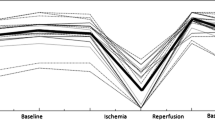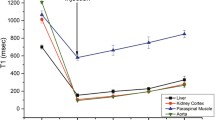Abstract
Multispectral imaging (MSI) is a new, non-invasive method to continuously measure oxygenation and microcirculatory perfusion, but has limitedly been validated in healthy volunteers. The present study aimed to validate the potential of multispectral imaging in the detection of microcirculatory perfusion disturbances during a vascular occlusion test (VOT). Two consecutive VOT’s were performed on healthy volunteers and tissue oxygenation was measured with MSI and near-infrared spectroscopy (NIRS). Correlations between the rate of desaturation, recovery and the hyperemic area under the curve (AUC) measured by MSI and NIRS were calculated. Fifty-eight volunteers were included. The MSI oxygenation curves showed identifiable components of the VOT, including a desaturation and recovery slope and hyperemic area under the curve, similar to those measured with NIRS. The correlation between the rate of desaturation measured by MSI and NIRS was moderate: r = 0.42 (p = 0.001) for the first and r = 0.41 (p = 0.002) for the second test. Our results suggest that non-contact multispectral imaging is able to measure changes in regional oxygenation and deoxygenation during a vascular occlusion test in healthy volunteers. When compared to measurements with NIRS, correlation of results was moderate to weak, most likely reflecting differences in physiology of the regions of interest and measurement technique.



Similar content being viewed by others
References
Lal C, Leahy MJ. An updated review of methods and advancements in microvascular blood flow imaging. Microcirculation. 2016;23(5):345–63.
Eriksson S, Nilsson J, Sturesson C. Non-invasive imaging of microcirculation: a technology review. Med Devices (Auckl). 2014;7:445–52.
Segal SS. Regulation of blood flow in the microcirculation. Microcirculation. 2005;12(1):33–45.
Stens J, de Wolf SP, van der Zwan RJ, Koning NJ, Dekker NA, Hering JP, et al. Microcirculatory perfusion during different perioperative hemodynamic strategies. Microcirculation. 2015;22(4):267–75.
Koning NJ, Atasever B, Vonk AB, Boer C. Changes in microcirculatory perfusion and oxygenation during cardiac surgery with or without cardiopulmonary bypass. J Cardiothorac Vasc Anesth. 2014;28(5):1331–400.
Koning NJ, Vonk AB, van Barneveld LJ, Beishuizen A, Atasever B, van den Brom CE, et al. Pulsatile flow during cardiopulmonary bypass preserves postoperative microcirculatory perfusion irrespective of systemic hemodynamics. J Appl Physiol. 2012;112(10):1727–1734.
Jhanji S, Lee C, Watson D, Hinds C, Pearse RM. Microvascular flow and tissue oxygenation after major abdominal surgery: association with post-operative complications. Intensive Care Med. 2009;35(4):671–7.
Lee JH, Park YH, Kim HS, Kim JT. Comparison of two devices using near-infrared spectroscopy for the measurement of tissue oxygenation during a vascular occlusion test in healthy volunteers (INVOS(R) vs InSpectra). J Clin Monit Comput. 2015;29(2):271–8.
Lipcsey M, Woinarski NC, Bellomo R. Near infrared spectroscopy (NIRS) of the thenar eminence in anesthesia and intensive care. Ann Intensive Care. 2012;2(1):11.
Abdelmalak BB, Cata JP, Bonilla A, You J, Kopyeva T, Vogel JD, et al. Intraoperative tissue oxygenation and postoperative outcomes after major non-cardiac surgery: an observational study. Br J Anaesth. 2013;110(2):241–9.
Bernet C, Desebbe O, Bordon S, Lacroix C, Rosamel P, Farhat F, et al. The impact of induction of general anesthesia and a vascular occlusion test on tissue oxygen saturation derived parameters in high-risk surgical patients. J Clin Monit Comput. 2011;25(4):237–44.
Lu G, Fei B. Medical hyperspectral imaging: a review. J Biomed Opt. 2014;19(1):10901.
Muselimyan N, Swift LM, Asfour H, Chahbazian T, Mazhari R, Mercader MA, et al. Seeing the invisible: revealing atrial ablation lesions using hyperspectral imaging approach. PLoS ONE. 2016;11(12):e0167760.
Cancio LC, Batchinsky AI, Mansfield JR, Panasyuk S, Hetz K, Martini D, et al. Hyperspectral imaging: a new approach to the diagnosis of hemorrhagic shock. J Trauma. 2006;60(5):1087–95.
Gillies R, Freeman JE, Cancio LC, Brand D, Hopmeier M, Mansfield JR. Systemic effects of shock and resuscitation monitored by visible hyperspectral imaging. Diabetes Technol Ther. 2003;5(5):847–55.
Greenman RL, Panasyuk S, Wang X, Lyons TE, Dinh T, Longoria L, et al. Early changes in the skin microcirculation and muscle metabolism of the diabetic foot. The Lancet. 2005;366(9498):1711–7.
Jeffcoate WJ, Clark DJ, Savic N, Rodmell PI, Hinchliffe RJ, Musgrove A, et al. Use of HSI to measure oxygen saturation in the lower limb and its correlation with healing of foot ulcers in diabetes. Diabet Med. 2015;32(6):798–802.
Khaodhiar L, Dinh T, Schomacker KT, Panasyuk SV, Freeman JE, Lew R, et al. The use of medical hyperspectral technology to evaluate microcirculatory changes in diabetic foot ulcers and to predict clinical outcomes. Diabetes Care. 2007;30(4):903–10.
Chin JA, Wang EC, Kibbe MR. Evaluation of hyperspectral technology for assessing the presence and severity of peripheral artery disease. J Vasc Surg. 2011;54(6):1679–88.
Mayeur C, Campard S, Richard C, Teboul JL. Comparison of four different vascular occlusion tests for assessing reactive hyperemia using near-infrared spectroscopy. Crit Care Med. 2011;39(4):695–701.
Tseng SH, Bargo P, Durkin A, Kollias N. Chromophore concentrations, absorption and scattering properties of human skin in-vivo. Opt Express. 2009;17(17):14599–617.
Scheeren TW, Schober P, Schwarte LA. Monitoring tissue oxygenation by near infrared spectroscopy (NIRS): background and current applications. J Clin Monit Comput. 2012;26(4):279–87.
Fellahi JL, Butin G, Fischer MO, Zamparini G, Gerard JL, Hanouz JL. Dynamic evaluation of near-infrared peripheral oximetry in healthy volunteers: a comparison between INVOS and EQUANOX. J Crit Care. 2013;28(5):881.e1–6.
Steenhaut K, Lapage K, Bove T, De Hert S, Moerman A. Evaluation of different near-infrared spectroscopy technologies for assessment of tissue oxygen saturation during a vascular occlusion test. J Clin Monit Comput. 2016;31(6):1151–58.
Hyttel-Sorensen S, Hessel TW, Greisen G. Peripheral tissue oximetry: comparing three commercial near-infrared spectroscopy oximeters on the forearm. J Clin Monit Comput. 2014;28(2):149–55.
Samra SK, Stanley JC, Zelenock GB, Dorje P. An assessment of contributions made by extracranial tissues during cerebral oximetry. J Neurosurg Anesthesiol. 1999;11(1):1–5.
Creteur J, Carollo T, Soldati G, Buchele G, De Backer D, Vincent JL. The prognostic value of muscle StO2 in septic patients. Intensive Care Med. 2007;33(9):1549–56.
Futier E, Christophe S, Robin E, Petit A, Pereira B, Desbordes J, et al. Use of near-infrared spectroscopy during a vascular occlusion test to assess the microcirculatory response during fluid challenge. Crit Care. 2011;15(5):R214.
Georger JF, Hamzaoui O, Chaari A, Maizel J, Richard C, Teboul JL. Restoring arterial pressure with norepinephrine improves muscle tissue oxygenation assessed by near-infrared spectroscopy in severely hypotensive septic patients. Intensive Care Med. 2010;36(11):1882–9.
Neviere R, Mathieu D, Chagnon JL, Lebleu N, Millien JP, Wattel F. Skeletal muscle microvascular blood flow and oxygen transport in patients with severe sepsis. Am J Respir Crit Care Med. 1996;153(1):191–5.
Gomez H, Torres A, Polanco P, Kim HK, Zenker S, Puyana JC, et al. Use of non-invasive NIRS during a vascular occlusion test to assess dynamic tissue O(2) saturation response. Intensive Care Med. 2008;34(9):1600–7.
Bezemer R, Lima A, Myers D, Klijn E, Heger M, Goedhart PT, et al. Assessment of tissue oxygen saturation during a vascular occlusion test using near-infrared spectroscopy: the role of probe spacing and measurement site studied in healthy volunteers. Crit Care. 2009;13(Suppl 5):S4.
Funding
This research did not receive any specific Grant from funding agencies in the public, commercial, or not-for-profit sectors.
Author information
Authors and Affiliations
Contributions
AB—study design, data collection, data analysis, interpretation of data, drafting manuscript, final approval. DG—data collection, data analysis, interpretation of data, drafting manuscript, final approval. JB—data collection, data analysis, interpretation of data, revising manuscript, final approval. JK—data collection, interpretation of data, revising manuscript, final approval. RV—study design, interpretation of data, revising manuscript, final approval. CB—study design, interpretation of data, revising manuscript, final approval.
Corresponding author
Ethics declarations
Conflict of interest
The authors have no conflict of interest to declare.
Ethical approval
This investigation involved Human Participants. The study was approved by the Human Subjects Committees of the VU Medical Center (METc 2016.315/NL56684.029.16). All participants provided written informed consent.
Additional information
Publisher's Note
Springer Nature remains neutral with regard to jurisdictional claims in published maps and institutional affiliations.
Rights and permissions
About this article
Cite this article
Bruins, A.A., Geboers, D.G.P.J., Bauer, J.R. et al. The vascular occlusion test using multispectral imaging: a validation study. J Clin Monit Comput 35, 113–121 (2021). https://doi.org/10.1007/s10877-019-00448-z
Received:
Accepted:
Published:
Issue Date:
DOI: https://doi.org/10.1007/s10877-019-00448-z




